USS Kentucky
Picture
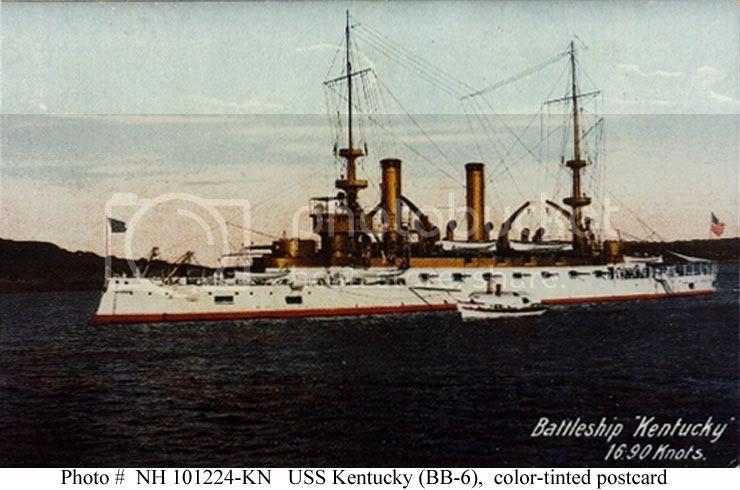
General Statistics
Displacement: 11,520 tons
Length: 375.3 feet
Beam: 72.3 feet
Draft: 37 feet
Speed: 16.9 knots
Complement: 554 officers and men
Armament: 4 x 13 inch guns
14 x 6 inch guns
20 x 6 pounder guns

An Outboard profile plan, October 1899, showing the ships as built for the USS Kearsarge (BB-5) and USS Kentucky (BB-6). It includes a wave profile based on trials of Kearsarge at a speed of 17.3 knots.
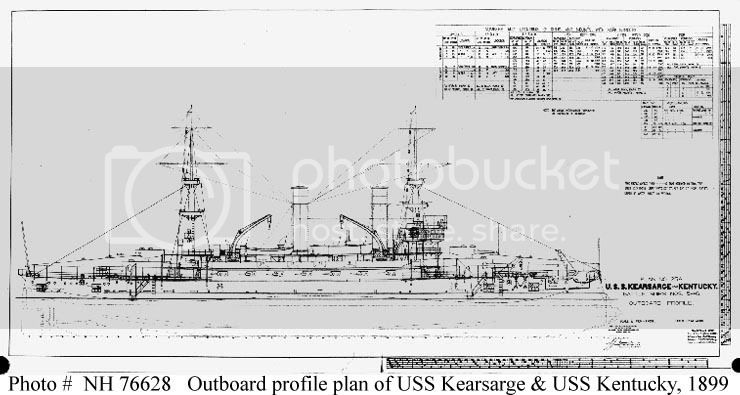
Inboard profile plan, 1899, showing the ships as built for the USS Kearsarge (BB-5) and USS Kentucky (BB-6).
It includes general arrangement of the ammunition hoists that supplied the superimposed 13-inch and 8-inch gun turrets.

Armor plan, 1899, showing the distribution of side and turret armor for the USS Kearsarge (BB-5) and USS Kentucky (BB-6).
.

General arrangement plan for the main deck, as designed for the USS Kearsarge (BB-5) and USS Kentucky (BB-6).
.

A Midship section plan, through the conning tower at Frame 33, showing the ships as designed for the USS Kearsarge (BB-5) and USS Kentucky (BB-6).
The arrangement of armor is depicted, along with one 5"/40 broadside gun, an 18-inch above-water torpedo tube, and the steering wheels in both the armored conning tower and the pilothouse.
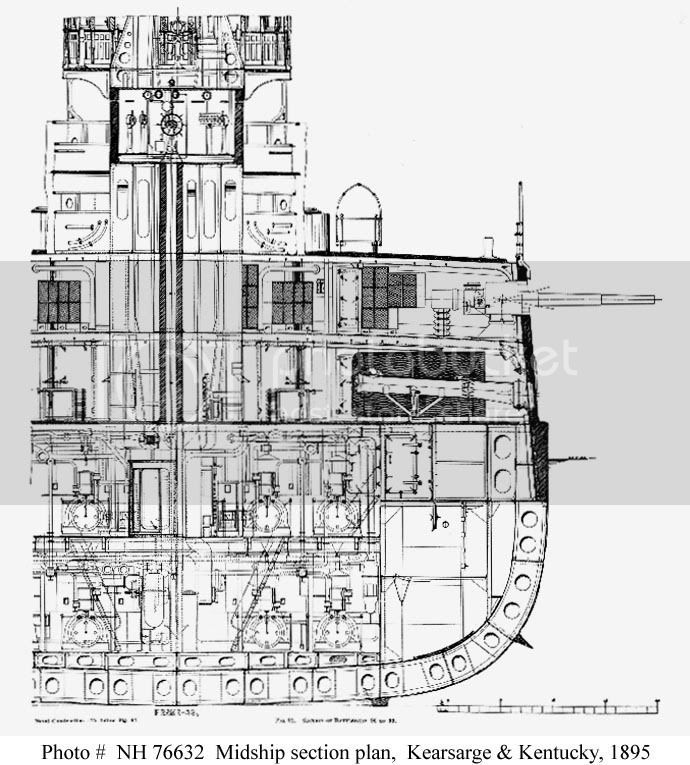
USS Kentucky (BB-6), a Kearsarge class battleship, was launched on the 24 of March 1898 by Newport News Shipbuilding & Dry Dock Company of Newport News, Virginia sponsored by Miss Christine Bradley, daughter of Governor William Bradley of Kentucky, and commissioned on 16 May 1900 with Captain Colby M. Chester in command.
A picture showing her ready for launching at the Newport News Shipbuilding and Dry Dock Company shipyard, Newport News, Virginia, 24 March 1898.
Note the chalk marks on her hull plating, indicating the planned location of fittings and gun ports.
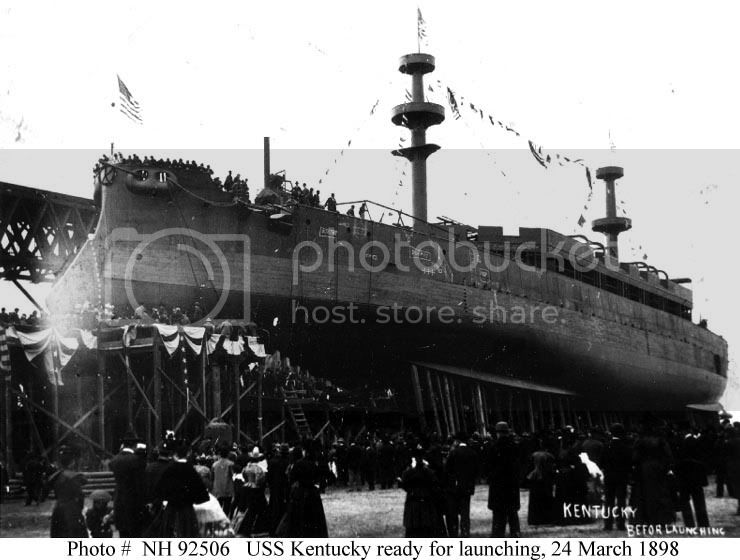
After fitting out in New York Navy Yard during the summer, Kentucky sailed on the 26th of October 1900 for the Far East via Gibraltar and the Suez Canal. She joined the other American ships on the Asiatic Station at Manila February 1901 and six days later sailed for Hong Kong where she became flagship of the Southern Squadron under Rear Admiral Louis Kempff on the 23rd of March. Throughout the following year the battleship led her squadron as it watched over American interest in the Far East, visiting principal ports of China and Japan including Chefoo, Taku, Nanking, Woosung, Hong Kong, Amoy, Nagasaki, Kobe, and Yokohama.
The USS Kentucky photographed in July 1900, a few months after she was commissioned.
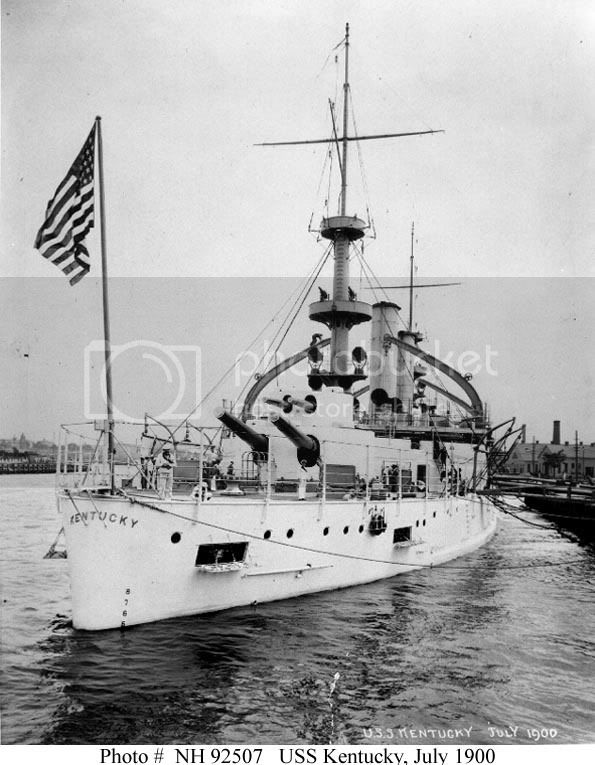
Rear Admiral Frank F. Wildes also selected Kentucky as his flagship upon relieving Admiral Kempff on the 1st of March 1902, but he transferred his flag to Rainbow on the 7th of April. Rear Admiral Robely D. Evans, Commander in Chief, Asiatic Fleet, chose Kentucky as his flagship at Yokohama on the 4th of November; and he continued to direct American naval operations in the Far East from her until she sailed from Manila for home on the 13 of March 1904. After retracing her steps through the Suez Canal and the Strait of Gibraltar she arrived New York City on the 23rd of May.
Upon completing overhaul in New York Navy Yard on the 26th of October, Kentucky devoted the following year for tactics and maneuvers off the Atlantic coast with the North Atlantic Fleet. The battleship joined the welcome of the British Squadron at Annapolis, Maryland, and New York City in the fall of 1905 and then cruised along the eastern seaboard until the 23rd of September 1906. On that day off Provincetown, she embarked Marines from Maine, Missouri, and Kearsarge and landed them at Havana, Cuba, on 1 October to protect American interests and property during the Cuban insurrection. She stood by to support forces ashore until the 9th of October before resuming battle practice and tactics in the North Atlantic.
Kentucky visited Norfolk, Virginia, on the 15th of April 1907 to attend the Jamestown Exposition, and, after more exercises off the New England coast, she returned to Hampton Roads to join the "Great White Fleet" .
USS Kentucky photographed circa 1905-08, after being repainted with buff color above the first superstructure deck and white below that level.
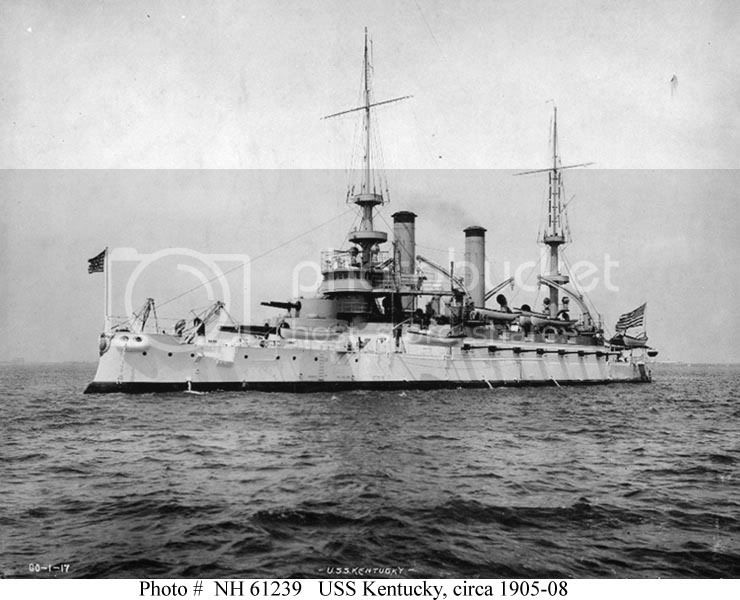
After local operations and repairs at Philadelphia Navy Yard, Kentucky decommissioned at Norfolk on the 28th of August 1909. She recommissioned in the Second Reserve on the 4th of June 1912 but, save for a run to New York, did not operate at sea before being placed in ordinary in Philadelphia Navy Yard on the 31st of May 1913.
A picture of the USS Kentucky off New York City during a Naval Review, circa 1912.
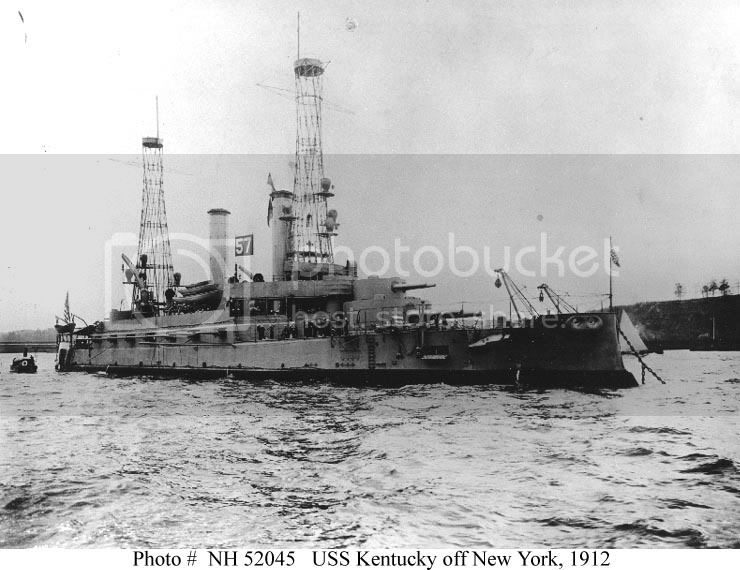
The veteran battleship was recommissioned at Philadelphia on the 23rd of June 1915 and sailed on the 3rd of July to train New York militia in a cruise from Long Island to ports in New England and Chesapeake Bay. She debarked the militia at New York and sailed to Portland, Maine, to embark Maine militia for a training cruise. Returning to Philadelphia the 31st of August, she sailed on the 11th of September for the coast of Mexico to watch over American interests during the unrest caused by the Mexican Revolution. She reached Veracruz on the 28th of September 1915; and, but for a visit to New Orleans, Louisiana, for Mardi Gras in March 1916, she remained on patrol off the Mexican coast until the 2nd of June 1916.
The USS Kentucky called at Guantanamo Bay and Santa Domingo en route home to Philadelphia, where she arrived the 18th of June. Following maneuvers and tactics ranging north to Newport, Rhode Island, during the summer, Kentucky arrived at New York on the 2nd of October and remained in the North River until the end of the year. She entered New York Naval Shipyard for repairs on the 1st of January 1917 and was still there when the United States entered World War I. She arrived at Yorktown, Virginia, on the 2nd of May for duty as a training ship and trained recruits on cruises in Chesapeake Bay and along the Atlantic coast as far north as Long Island Sound. When the Armistice was signed on the 11th of November 1918, she was training her 15th group of recruits, having already trained several thousand men for service in ships of the war-expanded Navy.
USS Kentucky photographed circa 1918, while serving as a training ship.
Most of her main deck 5-inch guns have been removed, leaving only those in the corners.
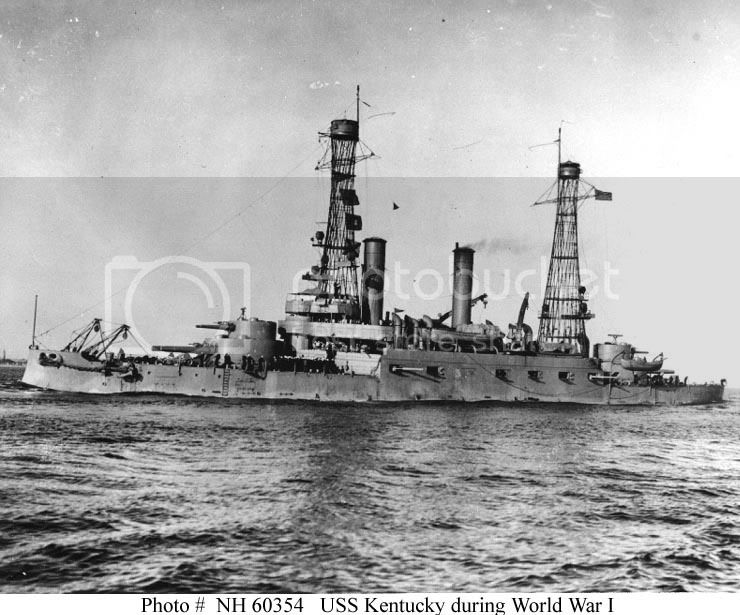
Kentucky entered Boston Navy Yard on the 20th December for overhaul. She sailed on the 18th of March 1919 for refresher training out of Guantanamo Bay and then participated in fleet maneuvers and exercises ranging north from Norfolk to the New England Coast. She arrived at Annapolis, Maryland, on the 29th of May to embark Midshipmen and got underway the 9th of June for a summer practice cruise that took her to Cuba, the Virgin Islands, Panama, New York, Boston, and Provincetown. She returned to Annapolis on the 27th of August to debark her Midshipmen and entered Philadelphia Navy Yard on the 30th of August. She remained there until decommissioning on the 29th of May 1920. Kentucky was sold to Dravo Construction Company, Pittsburgh, Pennsylvania, for scrapping on the 23rd of January 1924
Regards
Sean









